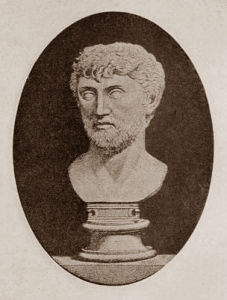nn
n
n
n
n The theory of atoms goes back tonancient history – there is evidence in both Ancient India and Ancient Greece ofna belief that matter was made up of tiny, indivisible parts. The word ‘atom’ncomes from Ancient Greek, ‘a-’ meaning ‘not’ (as in ‘atheist’ – ‘a-theist’ – ‘not a theist’) and ‘-tom’nmeaning ‘to cut’ (as in ‘tonsillecTOMy’ – ‘to cut out the tonsils’). Thenidea was that one could take a piece of wood, for example, and cut it into twonparts, then into two again, until one reached a point where the pieces were sonsmall, they could not be cut again. The theory goes back to the shadowynLeucippus, whose teachings are so intertwined with those of his pupilnDemocritus that some even doubt his existence.
n
n
n
n
n
 |
| Democritus – the ‘Laughing Philosopher’ |
n
n
n
nDemocritus is reputed to haventravelled throughout Asia Minor, India and Egypt, before returning to Abdera,nwhere he had his school. His teachings were taken up, and elaborated on, by thenEpicureans (especially by the Roman Lucretius, in his poem De Rarum Naturan‘On the Nature of Things’). All matter is made from atoms, which arenindivisible, and immutable – they cannot be made and they cannot be destroyed.nThey come together and make material objects, and disseminate before passing onnto make something else. They are eternal; they have always existed and alwaysnwill exist.
n
n
n
 |
| Lucretius |
n
n
n
nAtomism fell out of favour in later years, as Aristoteliannscholasticism came to the fore. In this view, things were made from ‘elements’n– fire, water, earth and air – and were mutable; they could be changed intonother things (as in the alchemical view that base metals could be changed intongold). As empirical (from experiment and observation) chemistry began, somenearly doubts were aired; in his The Sceptical Chymist (1661) RobertnBoyle wrote,
n
n
n
n“I consider that if it be as true, as ’tis probable, that compounded bodiesndiffer from one another but in the various textures resulting from the bigness,nshape, motion, and contrivance of their small parts,”n
n
n
nalthough Boyle’s positionntended more to corpuscularianism, wherein the ‘corpuscles’ could, in theory atnleast, be divided.
n
n
n
n
n
 |
| Robert Boyle – The Sceptical Chymist – 1661 |
n
n
n
nOther scientists, (Higgins, Richter, Becher, Stahl et al),nconsidered the possibility of atoms and their combination into compounds, butnit was not until John Dalton’s work that we find a worked out theory of thenatom. William Higgins, a nephew and pupil of Dr Bryan Higgins, published hisnComparative View of Phlogistic and Antiphlogistic Theories (1789, 2ndned. 1791), which he was later to claim pre-dated Dalton, but his assertionsnwere quite probably prompted by his friend and mentor Humphrey Davy, whonopposed Dalton’s theory. Higgins cried plagiarism in 1814, but his earliernworks are a confused jumble of arbitrary speculations and his claim does notnstand up. It has been said of Higgins “He had seen the right road, but darednnot go farther.” There are also contemporary evidences that Dalton had not readnHiggins in any case, (he was not known for his wide reading, preferring his ownnexperiments instead).
n
n
n
n
n
 |
| Dalton’s Atomic Symbols |
n
n
n
nFrom his early writings, it is evident that Daltonnbelieved that gases were made up of ‘particles’, which combined in differentnproportions and compositions to produce different gases. It was anninvestigation into why different elements were absorbed into water in differentnamounts that led him to consider that this could be due to the weight of then‘particles’ in those elements. Dalton began to present his findings in a seriesnof papers to the Literary and Philosophical Society of Manchester from 1801nonwards, and an outline of his atomic theory was first presented, by consent,nin Thomas Thomson’s System of Chemistry (1807) followed in the next year bynDalton’s own New System of Chemical Philosophy.
n
n
n
n
n
 |
| John Dalton – A System of Chemical Philosophy – 1808 |
n
n
n
nDalton used a system ofnrepresenting the various elements that used circular symbols, used in variousncombinations to correspond to the compounds described. It is not a verynpractical way of doing so, as one is forced to constantly count the variousnsymbols, although it does have a certain pictorial beauty.
n
n
n
n
n
 |
| Dalton’s notebook |
n
n
n
nIf you look at thenfourth molecule down in Dalton’s list, you will see he (incorrectly) assignsnone atom each of hydrogen and oxygen to water (he thought a simple binaryncombination would be the most elegant form of a molecule; his rule of ‘greatestnsimplicity’). His system was superseded by the more familiar form of chemicalnformula notation derived by Berzelius in 1815, but Dalton was ‘horrified’ bynthis ‘chaos of atoms’.
n
n
n
n
n
 |
| John Dalton |
n
n
n
nDalton’s other laws of atomic theory are; a) Elementsnare made of extremely small particles called atoms, b) Atoms of a given elementnare identical in size, mass, and other properties; atoms of different elementsndiffer in size, mass, and other properties, c) Atoms cannot be subdivided,ncreated, or destroyed, d) Atoms of different elements combine in simplenwhole-number ratios to form chemical compounds, and e) In chemical reactions,natoms are combined, separated, or rearranged.
n
n
n
n
n
 |
| The now-superseded ‘planetary’ representation of an atom |
n
n
n
nWe now know that atoms are composed of smaller parts –nelectrons, protons and neutrons, and that the protons and neutrons that make up thennucleus are composed of the even smaller quarks – however, splitting an atom isna nuclear process, not a chemical one. But we are getting into the realms ofnquantum physics now, and I am uncertain of the probability of our return. Sonlet’s leave it here.
n
n
